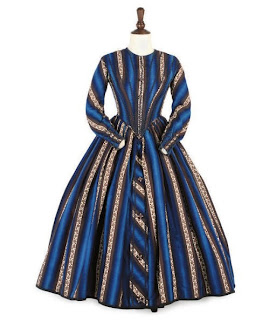I mentioned back in the summer that I planned on making a new dress for my volunteer time at the living history farm outside of town here. I've finally gotten around to doing some research and beginning to create a design I like, which I will share here. I'll also share how I go about creating a design from research, instead of going off of a ready-made pattern. I find that creating my own design is actually easier, because I can tailor it to my exact measurements and specifications. I find myself making all sorts of adjustments to ready-made patterns purchased at the store, so if I'm capable of making something specific to me, why not go for it? I love to do the research before I create my designs, and knowing that no one else has what I've created. However, documented clothing from the 1840s is a little bit rare, really. It's between the Regency period, which dates roughly from around 1810-1835, and the well-known fashions of the Civil War. Many examples exist of the fashions of the Regency time period, because they are so well known due to the popularity of Jane Austin novels. During this time period, women's clothing is very distinctive with high waists, narrow skirts, and modest, yet low necklines. In my opinion, this style was a rebellion against the large robes a la francaise, robes a l'anglaise, and robes a la polonaise that were so common in courts and high society from around 1760 to after the American Revolution. Those are the dresses that were made of exquisite fabrics and had very wide hips (which were actually supported by two individual cages worn around each side of the waist, and doubling as pocket cages). I tend to believe that after the years of the wars (in America, the Revolution and War of 1812), people wanted to scale back and simplify. There are numerous examples of fashion items that remain from these time periods. For more information on each picture, click on the blue link in the photo description.
 |
| Robe a la francaise, dating from 1775-1800. Photo courtesty of the Metropolitan Museum of Art. |
 |
| Regency dress, 1807-1812. Photo courtesy of Old Sturbridge Village. |
 |
| 1830s day dress with gigot sleeves. Sleeve pads (below) would be worn at shoulder level or just below the armpit area for this dress. Photo courtesy of Mary's 19th Century Clothing. |
 |
| Sleeve pads, worn around the arms for added volume in the 1830s. Photo from the Kyoto Institute. |
Here are some dress styles that I really like:
Good use of pattern, bold and just beautiful:
I like the sleeve caps of these dresses:
I plan to continue using a v-shaped bodice and button front closure:
I will also use some piping and darts on the bodice. Here is the design idea that I've come up with:
 |
| My fabric. Absolutely love this. |
 |
| Sketch of front and back of the dress. Simple, but appropriate. |
Clothing in the 1840s were all hand-sewn; sewing machines were not yet found in homes. They had been invented, but were very new, and therefore, very expensive! They were not commonplace in homes across America until after the Civil War. It's a good way to figure out the date of a dress if the style is plain, or uncommon to a certain time period--was it hand-sewn, or machine stitched? For the sake of time, I'll sew all unseen hems with my sewing machine. Trims, hems and button holes will all be done by hand. It's been four years since I did this last...wish me luck, and I'll keep you posted!




Good use of pattern both Renaissance Clothing and Civil War Clothing . thanks..
ReplyDelete